 |
"Buddha offers fruit to the devil [Mara?]" from 14th century Persian manuscript The Jāmiʿ al-tawārīkh ("Compendium of Chronicles"). (Image source)
|
.
Ancient Persian inscriptions link Babylonian King Darius the Great to Siddhartha Gautama, the man who became the Buddha
Dramatic evidence has revealed the presence of Siddhartha Gautama, the man who became Buddha, as far west as Persia.
Family seals and records found at Persepolis, the ancient capital of the fourth Persian Emperor, Darius the Great, have been identified and associated with the names of Siddhartha Gautama and his father, Suddhodana Gautama.
The Persepolis Seals identified royals and other important personages within the Persian ruling sphere. Gautama was the name of the royal family of the Saka [Shakya, Sakka, or Scythian Clan] kingdom.
Analysis of Seals PFS 79, PFS 796 and PF 250 found among the collection of important seals in Persepolis, the Persian capital of Emperor Darius I, are purported to be the Gautama family according to an interpretation by Dr. Ranajit Pal (The Dawn of Religions in Afghanistan-Seistan-Gandhara and the Personal Seals of Gotama Buddha and Zoroaster, published in Mithras Reader: An Academic and Religious Journal of Greek, Roman, and Persian Studies. Vol. III, London, 2010, pg. 62).
The family crest bore the etching of a crown-headed king flanked by two totems, each a standing bird-headed winged lion. The Seal of Sedda depiction of a Sramana (Persepolis Seal PFS 79), a Lion-Sun shaman, is based on information gathered from a number of other seals: the name refers to Sedda Arta (Siddhartha), i.e., Siddha (Liberator of) and Arta (Universal Truth).

Persepolis Seal PFS 79 and outline. Seal of Seddha, standing ruler flanked by bird-headed Arya-Sramana priests of Indus-Vedic tradition, linked to Saka tribe (Scythians) royal family of King Suddhodana Gautama, and his son Prince Siddhartha. Seal art courtesy of Oriental Institute, Chicago.
The twin guardians each had the body of lion and the head and wings of a mythic sunbird (i.e., Egyptian sun-bearing falcon). The lion and falcon-gryphon motifs represented a pair of shramana [wandering ascetic] shamans. Therefore, the family seal associated with Gautama, described a royal person of the Arya-Vedic tradition.
A similar image of Buddhist iconography shows a Buddha seated on a “lion-throne” under a bejeweled tree with cosmic aides at his side. The Buddhist montage declares his enlightenment under the cosmic Sacred Tree of Illumination.
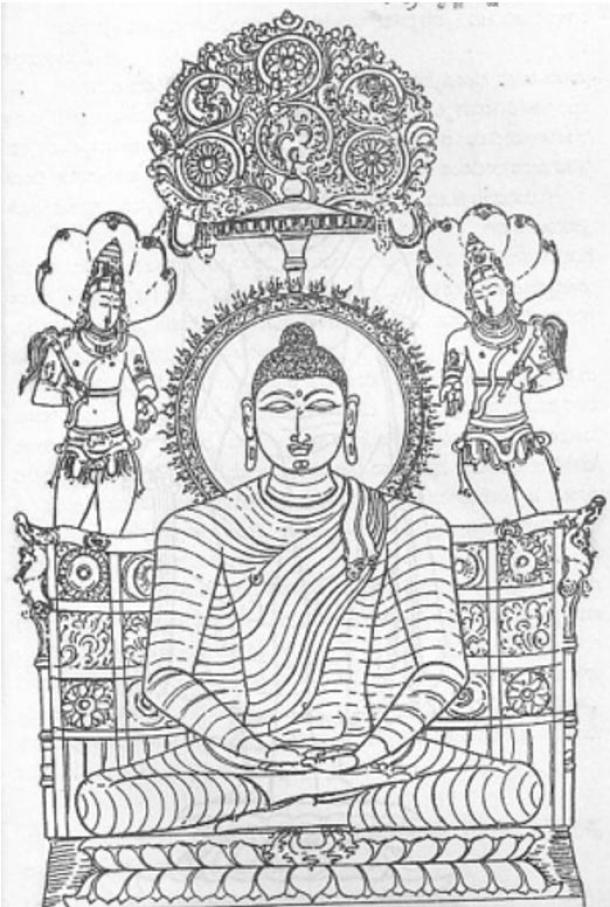
Possibly a modification of his family seal designed to reflect his new teachings, once Siddhartha Gautama achieves enlightenment this Buddhist emblem comes to represent him seated on the lion-throne under the sacred cosmic tree flanked by two celestial bodhisattvas.
What would the family crest of the Gautama family be doing in Persia? Was Siddhartha Gautama connected to the Persian Empire?
The inscriptions of Darius the Great (Persian Darayavaush), Persian emperor for 35 years, boast that the Zoroastrian God Assura Mazda (Persian Ahura Mazda) chose him to take the throne (in 522 BCE) from an usurper named “Gaumâta.”
{NOTE: This is interesting because in the East, three Dharmic religions -- Buddhism, Hinduism, and Jainism -- are on the side of the Devas ("Shining Ones," "angels") and a god named Maha Brahma. Devas are opposed by Asuras (Assura), "fallen devas" or "Titans," expelled from a celestial world by Sakka, King of the Devas, in the World of the Thirty-Three (Tavatimsa), in a story that echoes the Christian story of Archangel Michael expelling Lucifer (who then gets equated with Satan by everyone except maybe the tiny Yazidi religion) and casting him not into hell actually but down to earth. It has been suggested that the name "Asura" derives from Zoroaster's God the Zoroastrian deity "Ahura [Mazda]," more than its naïve origin-story of "non-beer" (anti-sura) or sworn off drinking alcohol because of the tale that Sakka got them drunk on a kind of brew in that world before he peacefully cast them out onto the base of Mt. Sumeru, this world.}
Darius shrouds the short-lived reign of his predecessor in a power struggle involving deceit, conspiracy, murder, and the prize of the Persian throne. He characterizes “Gaumâta” as an opportunist who illegally grabbed the throne in Babylon while the sitting Persian Emperor Kambujiya was away in Egypt.
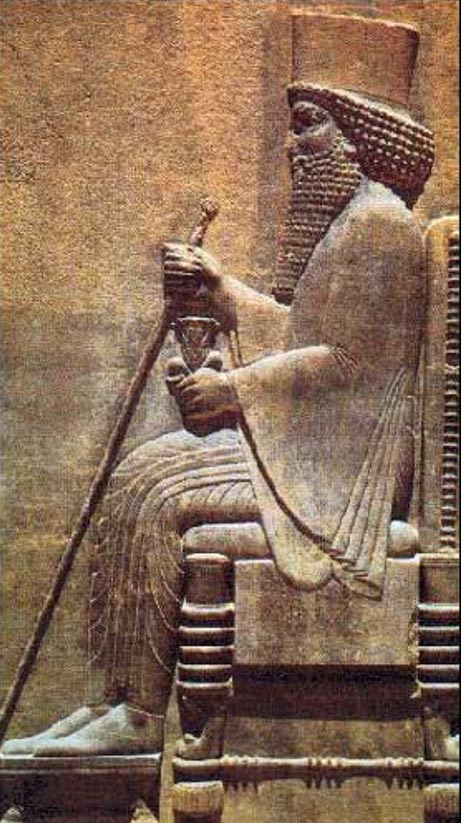
Relief carving of Darius the Great (Iran Chamber)
Written in the Cuneiform script on tablets at Mount Bisutun (aka Behistun) in three different languages: Old Persian, Elamite, and Babylonian (a form of Akkadian), the Bisutun Inscriptions may have echoed the name of Prince Siddhartha Gautama, the man who became the Buddha [the "Enlightened One" or the "Awakened One"], in the name of a little known King of Babylon.
The inscriptions refer to a religious figure named “Gaumâta,” from whom the Achaemenid Persian Emperor Darius the Great seized the throne in Babylon. Darius painted “Gaumâta” an imposter and illegal ruler, although the description does not seem to fit the highly educated and beloved leader [the Buddha].
Darius identified him as a Magi (practitioner of esoteric knowledge), and sardonically labeled him as a “stargazer.” If the name “Gaumâta” referred to Siddhartha Gautama, this reference would mean that he held a key leadership position in the Magi Order. Moreover, as the headquarters of the Magi was in the temple complex of Esagila ["temple whose top is lofty"], home of the ziggurat tower dubbed “House of the Raised Head,” the designation of “stargazer” suggests that Gautama was involved with Babylon’s star observatory.
Could it be that Siddhartha Gautama was the mysterious King “Gaumâta”? [Dr. Ranajit Pal (ranajitpal.com) would say yes.]
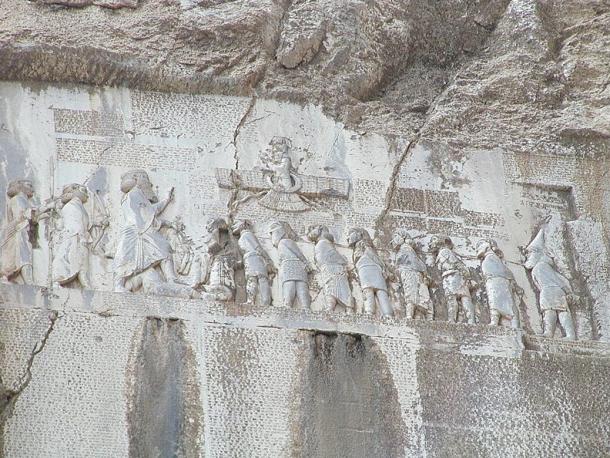 During lifetime of the Buddha (563-483 BCE), when the Persian Empire stretched from Egypt to the Indus, Darius the Great comes to power by overthrowing the stargazer-Magus "Gaumata" in Babylon about whom his Bisutun Inscriptions claim: "he seized the kingdom on July 1, 522 BCE. Then I prayed to Ahura-Mazda and slew him." Image of Darius, reasserting Persian domination, stomps on "rebels" with inscriptions etched below.
During lifetime of the Buddha (563-483 BCE), when the Persian Empire stretched from Egypt to the Indus, Darius the Great comes to power by overthrowing the stargazer-Magus "Gaumata" in Babylon about whom his Bisutun Inscriptions claim: "he seized the kingdom on July 1, 522 BCE. Then I prayed to Ahura-Mazda and slew him." Image of Darius, reasserting Persian domination, stomps on "rebels" with inscriptions etched below.
The name “Gaumâta” appears to be a variant of Gautama, the Buddha’s family name. In the ancient multilingual land of Babylonia, multiple names and titles with spelling variations referring to the same person were common.
Does evidence of the Babylonian Magi Order’s influences appear in Buddhist literature? Could we discover Mesopotamian references in the Buddhist scriptures?
The earliest mathematical systems, astronomical measurements, and mythological literature were initiated in the ziggurat tower-temples of the Fertile Crescent by the cultures of Sumer/Akkad and Amorite Babylonia. Both Magi and Vedic seers furthered knowledge of a cosmic infrastructure, well known in the Buddha’s time from the Tigris to the Ganges.
Discovering this connection in the Buddhist sutras would challenge the prevailing view that Buddhism was born and developed in isolation exclusively in India [actually simultaneously in Gandhara/Afghanistan, right next to Iran/Persia]. Although the oral legacy of the sutras were assembled and recorded later in India, a Babylonian finding would have major implications regarding the origin, influences, and intentions of the Buddha.
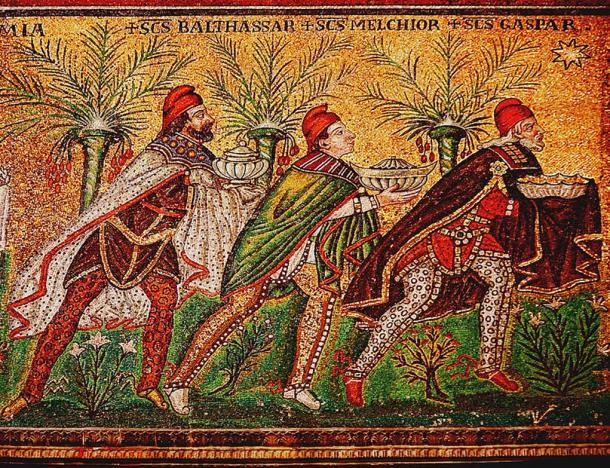 Byzantine depiction of the Three Magi in a 7th-century mosaic at Basilica of Sant'Apollinare Nuovo. (Wikimedia Commons)
Byzantine depiction of the Three Magi in a 7th-century mosaic at Basilica of Sant'Apollinare Nuovo. (Wikimedia Commons)[It sounds like the Buddha]
Described as a compassionate philosopher-cosmologist, “Gaumâta” decreed freedom for slaves, lowered oppressive taxes across the board, and inspired neighbors to respect one another in a city known for its diverse ethnic groups and many languages. His espousal of liberty, human rights, and generosity supports the thesis that “Gaumâta” and Gautama were one and the same person.
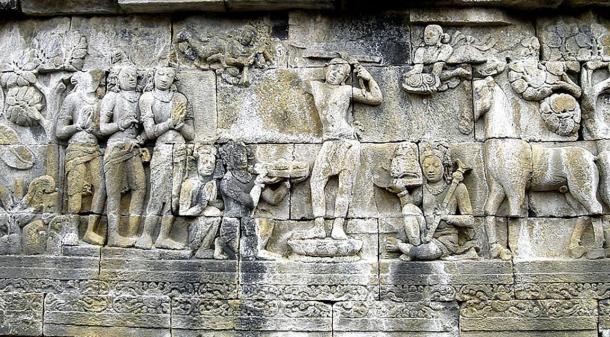 Prince Siddhartha Gautama shaves the hair off his head as a sign declining his status as a ksatriya (warrior class) royal and becomes an ascetic hermit. His servants hold his sword, crown, and princely jewelry while his horse, Kanthaka, stands on right. Bas-relief panel at Borobudur, Java, Indonesia. (Wikimedia Commons)
Prince Siddhartha Gautama shaves the hair off his head as a sign declining his status as a ksatriya (warrior class) royal and becomes an ascetic hermit. His servants hold his sword, crown, and princely jewelry while his horse, Kanthaka, stands on right. Bas-relief panel at Borobudur, Java, Indonesia. (Wikimedia Commons)
Darius, a military strongman, and a member of the Achaemenid family, prepared for his coup with a propaganda campaign designed to legitimize his overthrow of “Gaumâta.” In his public inscription he referred to his cohorts as witnesses who would confirm the killing of the usurper.
While his story appears to be full of cunning deceptions, the real behind the scenes story of this episode has remained elusive to history. Certainly as Darius had good reason to write history in his own self-interest, what happened has gone undetected for thousands of years because historians know little to nothing about “Gaumâta.”
Of course, if “Gaumâta” was really Siddhartha Gautama, this assassination had to be a lie, because he did go on to become the Buddha. Either someone else was murdered in the name of “Gaumâta,” or Darius shrewdly produced a disinformation campaign designed to cover up what really happened.
With the “death of the imposter,” the new emperor wanted to send a message to supporters of “Gaumâta” that he would not tolerate rebellions and suppressed any hope for the return of this popular leader. But in the wake of the coup 19 rebellions arose throughout the empire. It would take Darius more than a year of brutal military action to crush the liberation-minded communities inspired by “Gaumâta.” Source
- This article by Harvey Kraft is an extract from The Buddha from Babylon: The Lost History and Cosmic Vision of Siddhartha Gautama by Harvey Kraft and has been republished with permission.





















































































































































































































































No comments:
Post a Comment